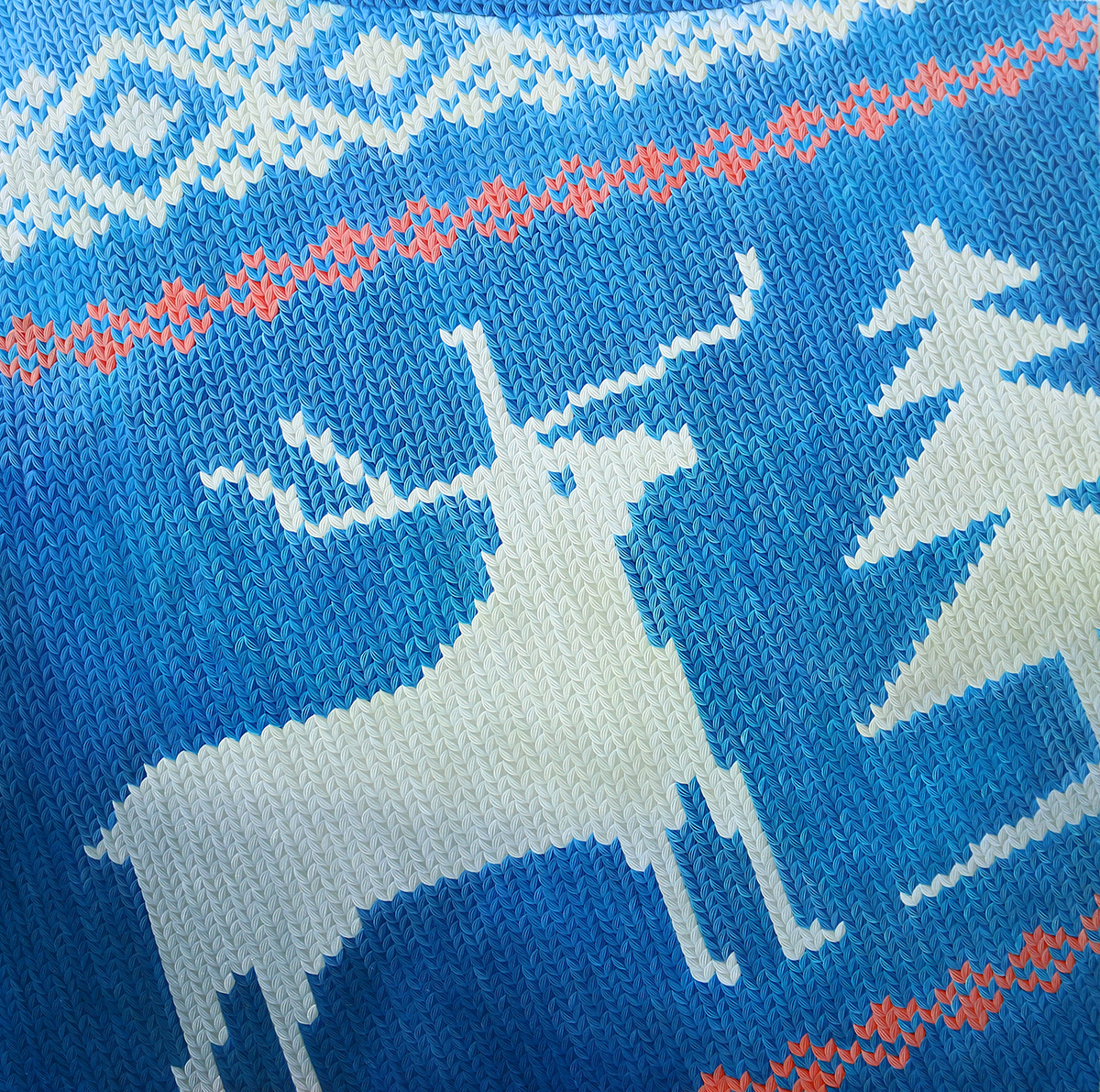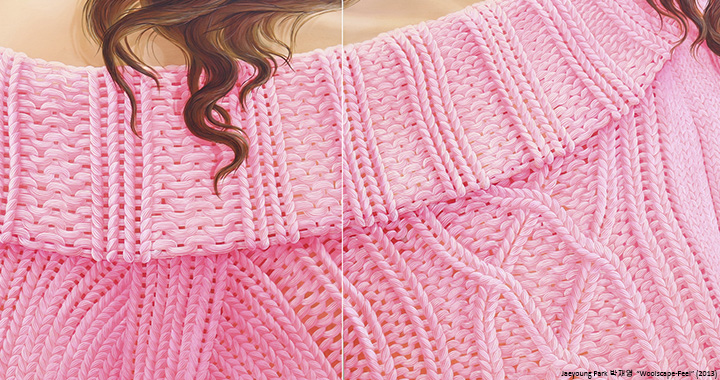박재영 개인전
May 23 – 27, 2018
Flexspace C, CICA Museum
‘woolscape’- Four Seasons
Statement
1. The motivation behind starting the ‘drawing a strand’ work
Modern people are living in the sea of images due to the advancement of mass media. Because of the overflow of various images, issues such as identity crisis, the loss of individuality, and moral paralysis have emerged. I have created work that recognizes these issues and searches for my identity along with expanding a range of various expressions.
My work was concerned with depicting a human body in a realistic manner, and due to overly complicated content and diverse methods of experiments, the image I intended to express through my work became less organized and more confusing. In order to solve this issue, I have gradually organized thoughts and theories and asked myself about what I truly want to address and express.
As I attempted to free myself from the desire to express a complicated image, my work began to gradually change and expand into the process of observing a small part and space in between, looking for images that are a part of life.
Also, my father’s work and my mother’s love for knitting, which I have observed since my childhood, allowed my life and memory to be the influence of my work.
From these influences, I started doing work that has the ongoing title ‘drawing a strand’ which disentangles an image of explicit memory as implicit memory.
2. What is a strand?
The strand in my work (string or thread) stands for a symbolic form that contains implicit memory and is repeatedly depicted as a strand (implicit memory) next to a strand (implicit memory).
The strands (implicit memory) are repeatedly woven, as in knitting work, and untied or tied in the process of expression.
The image (explicit memory) produced in the process is a close-up record of everyday life that takes place within the social structure.
3. Explanation of ‘drawing a strand.’
When it comes to the method of expression in modern painting, formative languages are diversely expressed based on how one interprets them. Then how should we interpret the act of drawing today?
How should we understand it under the Eastern tradition that prompted the concept of a line as the key element of connection among the traditional symbols?
Although my work obviously began with the Western vision and perspective, my attitude of drawing and practicing possess a mode of the East.
The form of a strand mostly consists of the linkage of lines in the overlaid structure of a knot, rather than showing a contour or a solid color. In addition, I emphasized the meaning of drawing a line by means of excluding emotions or implications through limiting decorative qualities.
The color of the work is simplified and moderate; the repeat of strands plays an important formative role that expresses internal memory (explicit memory).
The work seeks neutrality of drawing and furthermore utter objectivity. This work, containing color, repeating strands, enlargement, and separation, reflect psychological and mental characteristics of the human inner world and has distinctive qualities that set this work apart from the artist’s other work.
Woolscape (wool + landscape)
‘Woolscape’ concept
The ‘Woolscape’ (wood + landscape) image is positioned on the boundary between the reality of the object and the symbolic expression defined by the artist. The interpretation of the work embraces the dual aspects of minimalism and realism.
The intricate images shown in the process of drawing strands repeatedly arouses viewers’ curiosity and situational imagination regarding the story. While this work may seem realistic, it can be ideally seen as a symbolic pattern from which to read the structure of modern society. Although the repeated process of drawing a strand a day little by little can be monotonous, the acts of connecting and separating are generated within the relation between an individual and society which is the beginning and end of the day. The sense of satisfaction after completing the work, that takes the enduring physical pain of filling up a large surface, allows me to confirm my presence in life.
The concept of work
In the process of drawing woven cloths strand by strand, viewers can read the structure of modern society. Focusing on what it means to be an individual in a grouping society, the form of a strand, the minimum unit, does not stand out. It is just a part of larger clothing. However, the way strands are unwoven, tied, entangled, and embracing each other suggest a way of life in our society.
Like a sweater made up of small strands that warm people, small roles of individuals that might seem trivial, perhaps, form the grand identity of our society, making progress towards the brighter future.
The repeated action of lines carrying the neutrality of drawing, which is the artist’s intention, makes viewers think about the passage of time and feel human internal sensibilities from each work, suggesting a landscape akin to our society.
1.‘올 그려가기’ 작업을 시작하게 된 계기
현대인들은 매스미디어의 발달로 이미지의 홍수 속에 살아가고 있으며, 다양한 이미지의 범람에 의해 가치관의 혼란, 개성상실, 도덕관의 파괴 등의 문제점들을 낳고 있는데, 이러한 문제점을 인지하고 다양한 표현 영역의 확장과 더불어 자신의 정체성을 찾아가는 작업을 해왔다.
나의 작업은 사실적인 인체를 표현하는데 관심이 많았고, 너무 다양한 실험적 기법과 복잡한 내용들로 인해 그림에서 말하고자 하는 이미지가 정리되지 않고 혼란스러워져만 갔다. 그래서 작업 고민을 해결하기 위해 ‘내가 말하고 싶고, 그리고 싶은 것은 무엇인가?’ 에 대해 질문하고 개념과 이론을 조금씩 정리하면서 작업해 나갔다.
복잡한 이미지 표현에 대한 욕심을 털어내려 노력하면서부터 나의 작업은 부분, 사이, 틈을 보는 습관과 삶의 한 부분이라는 이미지를 찾아가는 과정으로 점차적으로 이미지는 확대되었고 변화 되었다.
또한 어린 시절부터 보아온 아버지의 직업, 뜨개질을 좋아하시는 어머니의 환경적인 영향은 본인의 작업에 삶의 기억과 경험들이 녹아 들었다.
이러한 계기로 외현적 기억의 이미지를 암묵적 기억의 형식으로 풀어가는, 진행형의 제목을 가진 ‘올 그려가기’ 작업을 하게 되었다.
2. 올 이란?
작품에 보여 지는 ‘올’(실이나 줄의 가닥)은 암묵적 기억을 담아내는 상징적인 형식으로 사용되며, 올(암묵적 기억)+올(암묵적 기억)로 반복적으로 그려진다.
‘올’(암묵적 기억)의 표현은 뜨개질하듯이 반복적인 선으로 엮어가거나, 풀어지고 매듭지어지는 과정을 거쳐 표현된다.
이렇게 생겨나는 이미지(외현적 기억)는 사회 구조 안에서 일어나는 일상의 세세한 삶의 기록이다.
3.‘올 그려가기’에 대해 설명
현대회화의 표현방법에 있어서 근거를 어디에 두느냐에 따라 조형적 언어가 다양하게 표현되고 있다. 그렇다면 오늘날의 그리기는 어떤 의미로 재해석되어야 할까?
전통적인 부호의 가장 주요한 연결요소로 선의개념을 내세웠던 동양적 전통 아래에서 그것을 어떻게 이해해야 할 것인가?
나의 작업은 분명 서양적인 비전과 시점에서 출발하였으나, 그리기의 자세와 수련의 과정은 동양적인 색채를 지니고 있다.
올의 형태는 윤곽을 나타내거나 색으로 채워지는 것이 아니라, 올은 대부분 선과 선의 결합으로 이루어져 있으며 중첩되어 매듭구조를 취한다. 또한 장식적인 면을 절제하여 어떠한 감정이나 연상 작용을 배제함으로써 선 그리기 행위의 의미를 부각시킨다.
작업에 나타난 색채는 단순화되고 절제된 색을 띠고 있으며, 올의 반복은 내면의 기억(외현적 기억)을 표출해 내는 중요한 조형적 역할을 한다.
그리기의 중립성과 나아가서 철저한 객관성을 추구하며, 내면의 심리적, 정신적인 특성을 반영한 색채, 올의 반복, 확대와 분할로 보여 지는 작품은 다른 작가의 작업들과 독특한 차별성을 갖고 있다.
Woolscape (wool + landscape)
‘Woolscape’ 개념
‘Woolscape’ (Wool+landscape)이미지는 대상의 실제성과 작가에 의해 설정된 상징적 표현의 경계선 사이에 자리 잡고 있으며, 작품해석에 있어서도 미니멀리즘과 리얼리즘의 양면적인 요소를 수용 할 수 있는 작업이다.
올을 반복해 그려가는 과정 속에서 보여 지는 디테일한 이미지는 이야기의 궁금증과 상황적 상상력을 불러일으키며 사실적으로 보이지만, 현대사회의 구조를 읽어 낼 수 있는 상징적인 패턴의 반복으로 다르게 보여 지길 바란다.
매일 조금씩 올을 그려가는 과정의 반복은 단조로울 수 있지만, 하루의 시작과 끝이라는 개인과 사회와의 관계성 안에서, 연결과 분할의 행위가 파생되어 나타난다. 이러한 대형 화면을 채워가는 과정에서 찾아오는 신체적인 고통을 인내하고 완성된 후에 접하게 되는 성취감은 곧바로 삶속 존재감을 확인케 한다.
작품내용
직조된 옷의 부분을 한 올 한 올 그려가는 과정에서 현대사회의 구조를 읽어 낼 수 있다.
집단화된 사회에서 개인의 존재가 어떤 의미를 갖는지에 초점을 맞추어 보면, 최소 단위 인 올의 모양은 성격을 갖지 못한다.
그저 커다란 옷의 일부분일 뿐이다. 하지만 올들의 조합이 풀어지고, 매듭지어지고, 엉키고, 서로 감싸주기도 하는 이러한 형태는 삶 속 우리의 사회의 모습과 흡사함을 느끼게 한다.
작은 올 하나가 모여 만들어지는 스웨터가 사람들에게 따스함을 주는 것처럼 우리가 사는 사회도 어쩌면 의미 없는 것처럼 보이는 개개인의 작은 역할이 모여 커다란 색을 가지며, 보다 나은 미래로 나아간다.
작가의 의도에 의해 그리기의 중립성을 가지는 선의 반복된 행위는 시간의 궤적을 유추하게 만들고, 각각의 작품들 마다 인간의 내면적 감성을 느끼게 하며, 우리사회의 모습과 흡사한 풍경으로 비춰진다.
The artist, Jae-young Park was born in 1973 in Seoul and graduated from Sun-hwa secondary school of Arts, Gye-won high school of Arts and reached both B.F.A. and M.F.A. in Western painting from Art college, Chung-Ang University, Korea.
He has held 6 Solo art shows from 2004 to 2018 as well as the double exhibition and tripple exhibition as special invitational exhibitions.
In addition, he has received several special awards from
Korea National Art Awards (3 times), Gu-sahng Art Awards, Song-eun Art Awards, Seo-li-pul Art Awards, So-sa-beol Fine Art’s Festival and e.t.c.
Plus, he also has been patispating in high-profile group exhibitions such as Han-ga-ram Art meseum, Se-jong Culture Center, In-sa Art Center, Seoul Art Center and e.t.c.
He also attended Christie’s Auction in Hong-Kong in 2007 where his art pieces got sold out.
You can also appreciate his art works at KIAF2007, DOORS ART FAIR both 2015 and 2018, Affordable Art Fair Milan
박재영은 1973년에 서울에서 태어나 선화예술중학교와 계원예술고등학교를 거쳐 중앙대학교 예술대학 서양화학과와 중앙대학교 대학원 서양화과를 졸업했다.
2004년 부터 2018년 까지 여섯번의 개인전을 가졌으며, 기획전으로 2인전과 3인전을 했다.
대한민국 미술대전(3회), 구상 미술대전, 송은 미술대전, 서리풀 미술대전, 소사벌 미술대전 등에서 수상을 했다.
한가람 미술관, 세종문화회관, 인사 아트센터, 예술의 전당 이외의 다양한 국내,외 그룹전에 참여했다.
2007년 홍콩 크리스티 경매에서 출품했고 낙찰되어 판매되었다.
KIAF2007, DOORS ART FAIR2015, 2018. Affordable Art Fair Milan에 참여했다.


Jae-young Park “woolscape -Feel Christmas” (2016)
